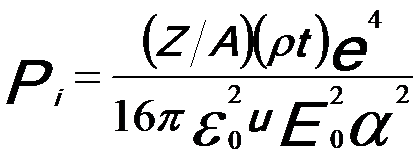=================================================================================
Inelastic electron scattering means that an energy loss from scattering is big enough to be detected in the electron microscopes. Inelastic scattering is characterized by interaction of incident electrons with the electrons of atomic shells. In this case, the atomic electrons in materials are excited into higher free energy levels above the Fermi level EF or into the energy continuum above vacuum level (E=0). Due to the energy change electrons after inelastic scattering are incoherent, and plasmons are the primary way of inelastic electron scattering. Simply speaking, inelastic scattering mainly involves electron-electron interactions and is mainly applied for analytical analyses such as EELS (electron energy loss spectroscopy) or EDS (energy dispersive X-ray spectrum) analysis. This excitation energy becomes an energy loss ΔE of the incident electron.
The inelastical phonon excitation of incident electrons is also known as thermal diffuse scattering (TDS). In TEM imaging, bright-field pictures are usually obtained at smaller angles and consist of a mixture of elastic, thermal diffuse, and inelastic scattering. When sample thickness exceeds few inelastic mean free paths (e.g. few hundreds of nanometers), the contribution of inelastic scattering dominates.
In the inelastic scattering process in EMs, the incident electron is scattered by an atomic electron rather than by the nucleus. The inelastic-scattering probability is given by,
 -------------------------------- [3817] -------------------------------- [3817]
where,
Z -- Atomic number of the element in the specimen
A -- Atomic mass number
ρ -- Atomic density (mass/volume)
t -- Specimen thickness
e -- Charge of electron
K -- (=1/4πε0) Coulomb constant
u -- Atomic mass unit
E0 -- Kinetic energy of incident electrons
α -- = K*Z*e2/(E0*a)
Incoherent electron scattering (not in phase) can be induced in uncorrelated scattering events from different scattering centers, for instance high angle elastic scattering or the inelastic scatterings. The combination of low angle elastic scattering with inelastic scattering can provide the information of Kikuchi bands.
Low-energy (meV) inelastic scattering events produce phonons. The effect of phonons are subsumed in the zero loss peak in EELS.
In EM systems, the development of energy-filtered imaging attachments [1 - 5] has allowed removing the intensity from electrons scattered inelastically by any mechanism other than phonon scattering.
Even though there is an energy spread (ΔE, 0.3 ~ 1.5 eV) in the electron sources, the major factor to the chromatic aberration (Cs) is the large energy loss ΔE (normally < 2 keV) induced by inelastic scattering when electrons pass through the specimen.
In TEM imaging, the spatial resolution degrades when a small objective aperture is used to reduce the inelastic scattering contribution to bright field images, or to exclude closely spaced spots to form dark field images.
Table 3817a shows that electrons interact with 1 electron, many electrons, 1 nucleus, and many nuclei in solids.
Table 3817a. Effects of interactions of electrons in solids.
| |
Interaction with electron(s) |
Interaction with nucleus/nuclei |
| |
1 electron |
Many electrons |
1 nucleus |
Many nuclei |
| Scattering type |
Inelastic |
Inelastic |
Quasi-elastic |
Elastic |
Inelastic |
| Scattering effect |
Electron Compton effect; electron excitation (from 50 eV to a few keV: EDS and EELS) |
Plasmon excitation (< 50 eV, ~100 nm TEM specimen); Cerenkov effect |
Rutherford scattering; phonon scattering (< 1 eV, heat) |
Bragg scattering |
Bremsstrahlung |
| Table 3817b. Electron scattering from a specimen in TEM measurements (Incoherent does not imply inelastic scattering; however, inelastic scattering is necessarily incoherent in EM measurements). |
Scattering type |
Energy loss |
Wave (phase) property |
Scattering direction |
Scattering angle |
Electron property |
Full name |
| Elastic |
No energy change of the wave after scattering |
Usually coherent (when the specimen
is thin and crystalline) |
Forward
scattering |
1° ~ 10° |
Wave |
Coherent elastic scattering |
| Incoherent |
> 10° |
Particle |
Incoherent elastic scattering |
| Back scattering |
|
| Inelastic |
There is energy change of the wave after scattering |
Almost always incoherent |
Forward
scattering |
< 1° |
Incoherent inelastic scattering |
| Coherent |
Does not exist in EM measurement, but it shows in neutron scattering |
|
|
Coherent inelastic scattering |
* Incoherence does not
imply inelastic scattering, while inelastic electron scattering is incoherent in electron microscopy.
** Inelastic scattering is not necessarily
incoherent in neutron scattering. |
In summary, the main inelastic scattering mechanisms are:
i) Phonon excitation (heat).
ii) Plasmon excitation (valence electrons).
iii) Single electron excitation (inner and outer shell scattering).
iv) Direct radiation losses (Bremsstrahlung radiation due to deceleration of the electron beam in the Coulomb field of an atom).
v) Excitation of conducting electrons leading to secondary electron emissions.
[1] T. Honda, T. Tomita, T. Kaneyama, Y. Ishida, Ultramicroscopy
54 (2–4) (1994) 132–144.
[2] O.L. Krivanek, A.J. Gubbens, N. Dellby, C.E. Meyer,
Microsc. Microanal. Microstruct. 3 (1992) 187–199.
[3] K. Tsuno, J. Electron Microsc. 48 (6) (1999) 801–820.
[4] K. Tsuno, T. Kaneyama, T. Honda, Y. Ishida, Nucl.
Instrum. Methods A 427 (1–2) (1999) 187–196.
[5] M. Tanada, K. Tsuda, M. Terauchi, K. Tsuno, T.
Kaneyama, T. Honda, Y. Ishida, J. Microsc. 194 (1999)
219–227.
|